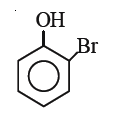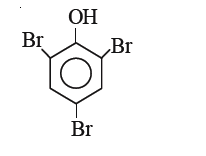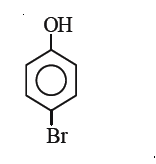Explain the reaction of ethene and ethyne with bromine water. How is this reaction used as test for unsaturation?
Step-by-Step Solution:
Step 1: Understanding the Reactants
- Ethene (C2H4) and ethyne (C2H2) are both hydrocarbons that contain carbon and hydrogen. Ethene has a double bond (C=C), while ethyne has a triple bond (C≡C).
- Bromine water is a solution of bromine in water, which has a reddish-brown color due to the presence of bromine molecules.
Step 2: Reaction of Ethene with Bromine Water
- When bromine water is added to ethene, the double bond in ethene reacts with bromine.
- The reaction can be represented as follows:
C2H4+Br2→C2H4Br2
- The product formed is 1,2-dibromoethane (C2H4Br2), which is colorless.
- As a result of this reaction, the reddish-brown color of bromine water disappears and the solution becomes colorless.
Step 3: Reaction of Ethyne with Bromine Water
- When bromine water is added to ethyne, the triple bond in ethyne reacts with bromine.
- The reaction can be represented as follows:
C2H2+2Br2→C2H2Br4
- The product formed is 1,1,2,2-tetrabromoethane (C2H2Br4), which is also colorless.
- Similar to the reaction with ethene, the reddish-brown color of bromine water disappears, resulting in a colorless solution.
Step 4: Test for Unsaturation
- The decolorization of bromine water indicates the presence of unsaturation (double or triple bonds) in the organic compound.
- If a compound is saturated (contains only single bonds), the addition of bromine water will not change its color; the solution will remain reddish-brown.
- Therefore, this reaction serves as a qualitative test for unsaturation in organic compounds.
- Ethene (C2H4) and ethyne (C2H2) are both hydrocarbons that contain carbon and hydrogen. Ethene has a double bond (C=C), while ethyne has a triple bond (C≡C).
- Bromine water is a solution of bromine in water, which has a reddish-brown color due to the presence of bromine molecules.
- When bromine water is added to ethene, the double bond in ethene reacts with bromine.
- The reaction can be represented as follows:
C2H4+Br2→C2H4Br2
- The product formed is 1,2-dibromoethane (C2H4Br2), which is colorless.
- As a result of this reaction, the reddish-brown color of bromine water disappears and the solution becomes colorless.
- When bromine water is added to ethyne, the triple bond in ethyne reacts with bromine.
- The reaction can be represented as follows:
C2H2+2Br2→C2H2Br4
- The product formed is 1,1,2,2-tetrabromoethane (C2H2Br4), which is also colorless.
- Similar to the reaction with ethene, the reddish-brown color of bromine water disappears, resulting in a colorless solution.
- The decolorization of bromine water indicates the presence of unsaturation (double or triple bonds) in the organic compound.
- If a compound is saturated (contains only single bonds), the addition of bromine water will not change its color; the solution will remain reddish-brown.
- Therefore, this reaction serves as a qualitative test for unsaturation in organic compounds.
Topper's Solved these Questions
- CARBON AND ITS COMPOUNDS BOOK - MTG IIT JEE FOUNDATIONCHAPTER - CARBON AND ITS COMPOUNDS EXERCISE - NCERT Section
33 Videos
- CARBON AND ITS COMPOUNDS BOOK - MTG IIT JEE FOUNDATIONCHAPTER - CARBON AND ITS COMPOUNDS EXERCISE - Exercise (Multiple Choice Questions) (LEVEL - 1)
30 Videos
- CARBON AND ITS COMPOUNDS BOOK - MTG IIT JEE FOUNDATIONCHAPTER - CARBON AND ITS COMPOUNDS EXERCISE - Olympaid/HOTS Corner
25 Videos
- ATOMIC STRUCTURE BOOK - MTG IIT JEE FOUNDATIONCHAPTER - ATOMIC STRUCTURE EXERCISE - Exercise (Integer/Numerical Value Type)
5 Videos
- CHEMICAL BONDING BOOK - MTG IIT JEE FOUNDATIONCHAPTER - CHEMICAL BONDING EXERCISE - Exercise (Integer/Numerical Value Type )
5 Videos
Similar Questions
Knowledge Check
The product of the reaction of phenol with bromine water is :
A B
B C
C DBoth (1) and (3)
DBoth (1) and (3)The product of the reaction of phenol with bromine water is :
A B
B C
C DBoth (1) and (3)
DBoth (1) and (3)Reaction of acetamide with bromine and KOH gives
ACH3COOHBCH3CH2NH2CCH3COONH4DCH3NH2.
Explain water gas shift reaction.
View SolutionExplain reaction of sodium, magnesium and iron with water.
View SolutionExplain the reaction of sodium and water with the help of an activity.
View SolutionThe reaction between ethylene and bromine is an example of:
View SolutionWhich reagent used to test unsaturation of alkenes ?
View Solution
